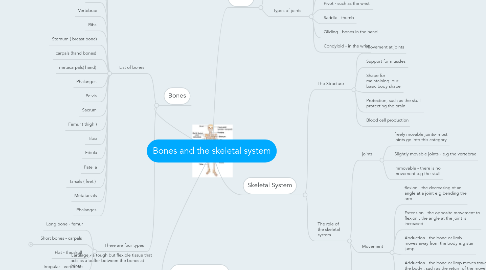
1. Bones
1.1. List of bones
1.1.1. Skull
1.1.2. Jaw bone
1.1.3. Clavicle ( collar bone)
1.1.4. Humerous
1.1.5. Radical
1.1.6. Ulna
1.1.7. Vertebrae
1.1.8. Ribs
1.1.9. Sternum ( breast bone)
1.1.10. carpals (hand bones)
1.1.11. metacarpals( hand)
1.1.12. Phalanges
1.1.13. Pelvis
1.1.14. Sacrum
1.1.15. Femur ( thigh )
1.1.16. Tibia
1.1.17. Fibula
1.1.18. Patella
1.1.19. Tarsals ( feet )
1.1.20. Metatarsals
1.1.21. Phalanges
1.2. There are four types
1.2.1. Long bone - femur
1.2.2. Short bones - carpals
1.2.2.1. Bones
1.2.3. Flat - the skull
1.2.4. Irregular - vertebrae
2. Connective tissue
2.1. Cartilage - a tough but flexible tissue that acts as a buffer between the bones at joints
2.2. Ligaments - bands of fibre attached to bones that link the joints
3. Skeletal System
3.1. The Structure
3.1.1. Movement at joints
3.1.2. Support for muscles
3.1.3. Shape for maintaining our basic body shape
3.1.4. Protection, such as the skull protecting the brain
3.1.5. Blood cell production
3.2. The role of the skeletal system
3.2.1. joints
3.2.1.1. freely movable joints- most joints go into this category
3.2.1.2. Slightly movable joints - e.g the vertebrae
3.2.1.3. immovable - there is no movement e.g the skull
3.2.2. Movement
3.2.2.1. flexion - the decreasing of an angle at a joint e.g bending the arm
3.2.2.2. Extension - the opposite movement to flexion , the angle at the joint is increased
3.2.2.3. Abduction - the bone or limb moves away from the body e.g star jump
3.2.2.4. Adduction - the bone or limp moves towards the body , such as the return of the movement of the arms and legs when performing a star jump
3.2.2.5. rotation - a turning action, such as turning your head to the side when breathing in front crawl
3.2.3. Tendons- very strong , non elastic cords that join the muscles to bone
4. Joints
4.1. A connection point between two bones where movement occurs.
4.2. Types of joints
4.2.1. hinge - elbow and the knee
4.2.2. ball and socket such as the hip and shoulder
4.2.3. Pivot - such as the wrist
4.2.4. Saddle - thumb
4.2.5. Gliding - bones in the hand
4.2.6. Condyloid - in the wrist
